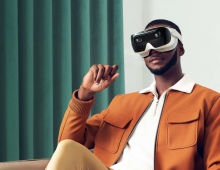
Intel Sees a More Immersive, Cordless Virtual Reality Future
Intel says that the current virtual reality (VR) experiences that allow to transport someone to a live concert where they can have a front-row seat is a great, but the goal should be a virtual reality experience that naturally merges the physical and virtual worlds.
Speaking at the Augmented World Expo, Achin Bhowmik, vice president and general manager of the Perceptual Computing Group at Intel, centered on this necessary evolution. "Rather than just watching the concert, imagine dancing with your friends in attendance and experiencing the same excitement from your living room through lifelike visuals, sound, touch, haptics and complete freedom of movement," he said.
According to Bhowmik, a realistic virtual reality experience requires freedom of movement. "Being connected to an external computer with cables handicaps a user's natural movement," he said. "The future of virtual reality must "cut the VR cord" allowing the user to operate freely, immersed within the experience"
And here comes the Intel RealSense technology, which enables VR headsets to sense depth, scan, map and navigate in the 3D environment. Additionally, Intel announced at Computex a cooperation with HTC to create a VR accessory that allows Vive customers to get high-fidelity, low-latency, VR experiences without the wire.
Freedom of mobility, or movement with "6 degrees of freedom" (6DOF), not only means an untethered experience, but one that also avoids collision with real-world objects while in a virtual environment. Intel has showcased this capability through Intel RealSense technology to accurately track head movement without the need for external sensors.
Today, many VR platforms employ sensors set up in a room to track the movement of a headset and controllers, corresponding to the displayed images in the headset of the virtual environment. These sensors require calibrating emitters to detect the movements of your head and render images accordingly. Intel says that in order for VR to become mainstream, and enter new verticals, the user experience must be simple without requiring external tracking setup.
Building upon the capabilities of Intel RealSense technologies, Intel leverages Intel Movidius' vision processing unit (VPU) for accelerating inside-out 6DOF tracking algorithms. "This reduces the need for elaborate and costly sets of external sensors and results in greater ease of use," Bhowmik said.
In addition, by integrating real hands into the virtual experience, you achieve a much more natural method of interaction, one that mirrors how we interact with the real world. Intel RealSense's depth-sensing camera technology, which senses and detects real-world objects, allows your real hands to figuratively grasp virtual-world objects for natural interactions. Instead of pressing a button on a controller to grab a virtual object, you can pick it up in your hands.
The strength of these natural interactions is enabled by a depth sensor along with a high-resolution color camera that allows users to visualize their hands. The embedded camera creates a natural perspective to see real people or objects as they enter the user's virtual field of view.
Finally, Bhowmik said that the future of virtual reality will go beyond computer-generated content by bringing real-world objects into the digital environment in real time. Virtual and physical worlds should be able to interface with each other directly.
"We are already seeing early prototypes of these integrated examples, such as through Intel's work with Surgical Theater, which provide surgeons with ways to rehearse a difficult procedure with their own surgical tools within a virtual rendering of the operation environment. This allows for not only better medical training, but for the patient to be brought along on the journey."

A culmination of these technological advances is found within Project Alloy - Intel's first-generation, performance-based, all-in-one VR headset. Announced in August 2016, the Alloy platform delivers a set of new experiences - dubbed merged reality - by using Intel's RealSense technologies that are optimized for VR usages.
Intel will open the Alloy hardware and provide open APIs for the ecosystem in 2017.




















